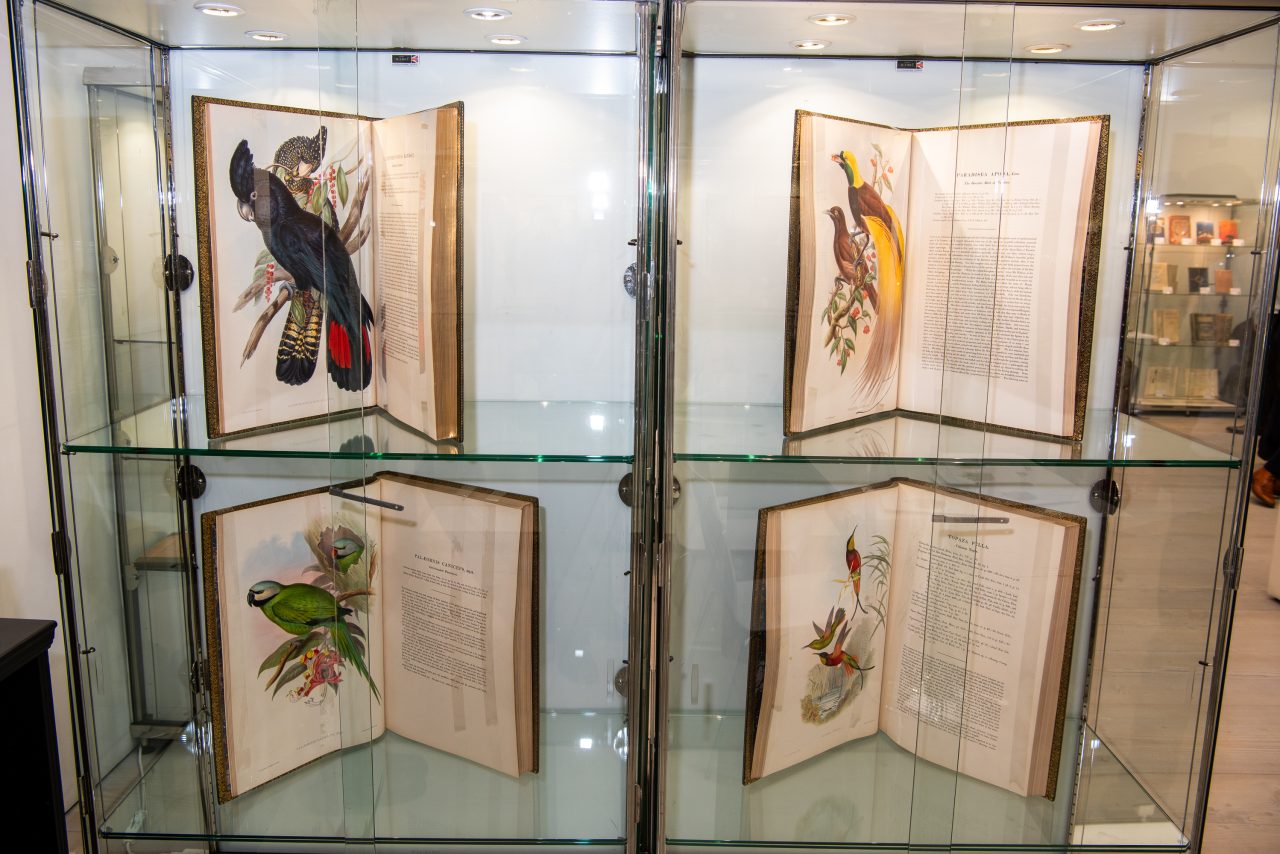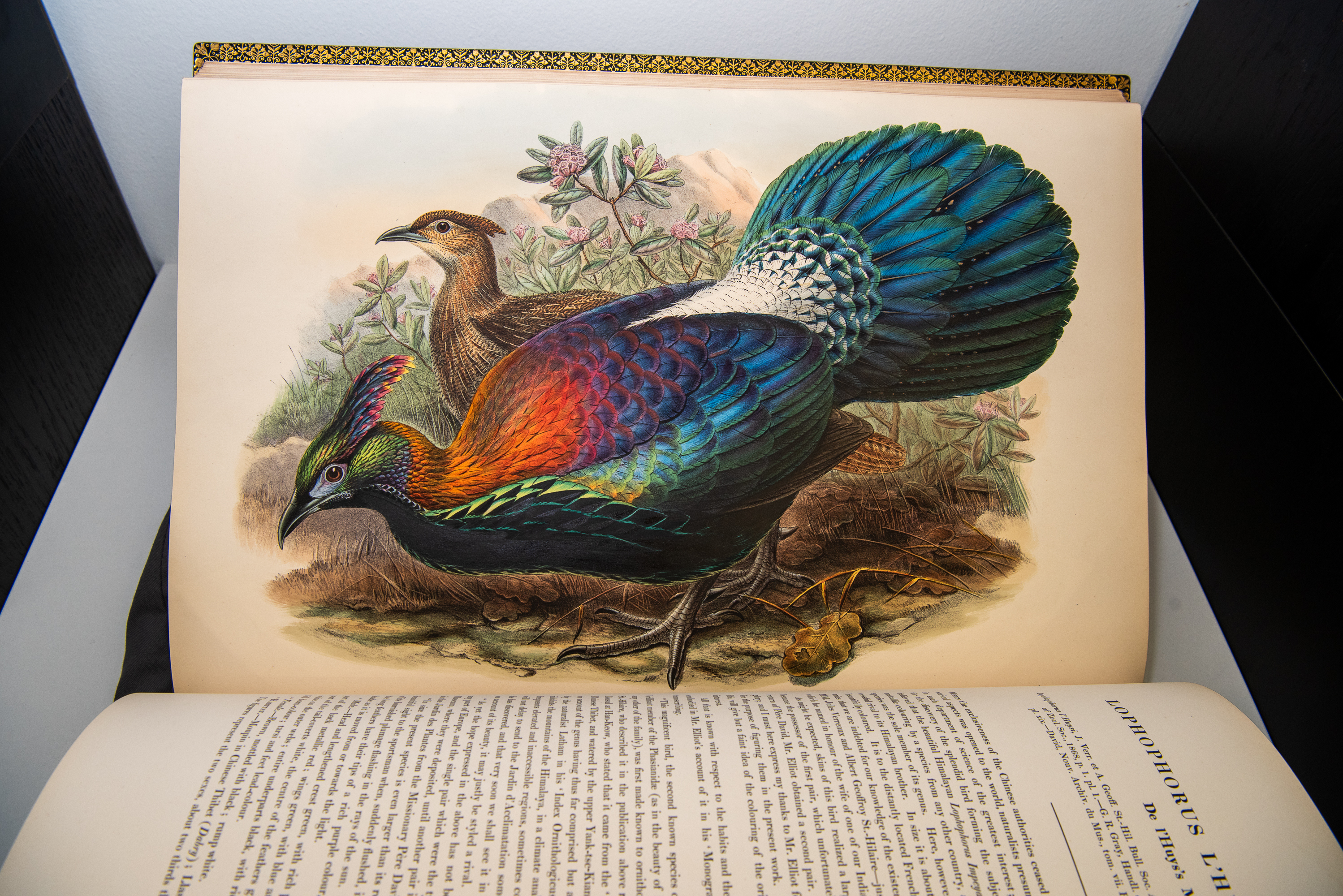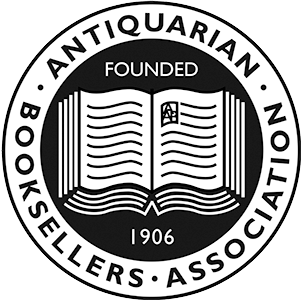ABA News
Collecting notes: When Sotherans Became the Publishers of John Gould’s Ornithological Works

By Robert Kirkman
John Gould’s monumental vision for his ornithological works was to illustrate the majority of birds at life-size, and resulted initially in three double-page plates in Birds of Australia and a long vertical folding plate of the bird Trogon Resplendens in the first edition. John Gould, Elizabeth Gould, Edward Lear, H. C. Richter, William Hart, and Joseph Wolf made the finished drawings which, afterwards, were redrawn on stone. In the early years these redrawings were done by Elizabeth Gould, afterwards by Richter, and by Hart from 1851 onwards. Together, they produced over 3,300 different lithograph bird plates for Gould’s ornithological works between 1832 and 1887 (I include the matching folio volumes of Mammals of Australia in the Gould canon). A leading s pecialist in natural history books once led me to believe that John Gould hand-coloured all of his own lithograph plates, which was a preposterous claim. We know that 750 copies of the Birds of Great Britain were printed, and 250 copies each of Gould’s monographs. If we take an average of 500 copies printed of each o f the 3,300 different lithograph plates throughout Gould’s works we come to a total number of 1,650,000 individual plates (over 1.6 million lithograph plates).
None of the lithograph plates were ever reprinted from the lithograph stones and, in view of the vast quantity of printed lithographs available to Sotherans when they purchased Gould’s publishing house (including the copyright) in 1881, there was no need to reprint. Practically speaking, not much could be done with over 3,300 heavy Solnhofen lithograph stones nearly the size of paving stones: Solnhofen limestone is soft and easily scratched or damaged. The lithograph stone for the snowy owl in Birds of Great Britain was dropped and cracked during the early stages of printing, which the colourists carefully disguised. This does not constitute a second issue but remains a production flaw. The stones were a liability and an embarrassment to Sotherans who disposed of them accordingly. Tradition within Sotherans holds that members of staff took some of the stones home for garden paths.
Experienced colourists, skilfully following the original publisher’s “pattern” plates, could handcolour no more than an average of one plate a day during daylight hours, if a high standard of colouring was to be maintained. The paper needed first to be dampened before handcolouring could commence, and the colourist needed to be patient between applying different layers of watercolour. In some cases plates were heightened with gum arabic. The iridescent throats of some hummingbird plates were touched with gold leaf before the uncoloured lithographs plates were passed to colourists. Therefore, we must calculate that for John Gould to have handcoloured all of his own lithograph plates, even working 365 days a year, it would have taken him more than 4,520 years.
Even with a good team of colourists (which was a cottage industry with most working from home), to have completed colouring of all his published works during Gould’s lifetime was unachievable. Gould originally published all his works in parts with cloth-backed boards and paper-covered sides, printed in black at £3.3s per part to subscribers, and Sotherans continued this practice. As an example, Birds of Great Britain was complete in 25 parts and Hummingbirds in 30 parts including supplement. Strictly speaking, only subscribers’ copies can be guaranteed to have contemporary colouring or volumes bound from the original parts in morocco, with subscriber’s bookplates, ownership inscriptions, or other convincing evidence. Birds of Great Britain was Gould’s most popular and subscribed work, with 468 subscribers out of an edition of of 750 copies, leaving 282 copies unsold for the retail market. In his introduction to Birds of Great Britain Gould wrote that every colourist in London was employed to meet customer demand.
During the 1870s and 1880s Sotherans were already publishing fine colour plate books, and these were the most active and productive years for them. When they purchased John Gould’s publishing house in its entirety they became the official publishers of his ornithological works. Birds of New Guinea, five volumes, 1875-1881, was published by Sotherans and bears the Sotherans imprint. The supplement to Hummingbirds was published in 1887 and also bears their imprint. In 1891-1898 they published Richard Bowdler Sharpe’s Birds of Paradise in two volumes, in an e dition of 350 copies, uniformly produced to match Gould’s canon of ornithological works.

As the official publishers, Sotherans continued to colour copies of Gould’s works as required to meet customer orders and to be sold in their bookshops in London, Manchester, and through their catalogues. Elegantly carved cabinets with plate glass doors were sometimes included with sets of Gould advertised in their catalogues. Colouring was not an inconsiderable expense and colour plate books were only coloured when required to meet customer demand. During my early years in the book trade there were some well-known West End London dealers, including Charles Sawyer, who held uncoloured remainder stocks of Butler’s South African Sketches of 1841, and Quaritch, who held uncoloured remainder stocks of Mivart’s Monograph of the Lories of 1896 with lithograph plates, which they continued to colour and bind well into the middle of the twentieth century.
With their vast quantity of books and plates, Sotherans continued to colour and bind Gould’s bird books as the official publishers. The approximate date of the binding remains a clue to the age of Sotherans colouring. For the first half of the twentieth century and beyond, it was generally accepted that colouring could have been executed at any time unless it was specifically described as “contemporary”. This was the accepted custom and practice of the antiquarian book trade when describing books with handcoloured plates, prints, and maps. Many antiquarian bookshops employed the services of a colourist. Nowadays, with few exceptions, the practice of ABA members employing the services of a colourist is less common, with colouring usually described as “later” in accordance with guidelines adopted in the early 1980s.
The term “contemporary” in relation to colouring can be loosely applied, but a modern entry in the Abebooks Glossary of Book Terms may be noted: “Contemporary – Refers to the time at which an action happened to the book in relation to its printing”.
***
Mrs. Enriqueta Augustina Rylands built the John Rylands library in memory of her husband John Rylands. She started buying books with the assistance of J. Arnold Green for the library in 1889. Tradition within Sotherans holds that she went into Henry Sotheran & Co. not exactly dressed to impress. She was ignored by the manager, who would normally jump from his seat to welcome wealthy customers. Owing to a sharp-eyed junior assistant who came from Manchester, the manager was informed that she was in fact one of the richest women in the country. The manager promptly went forward to greet Mrs. Rylands, who told him she had been in Quaritch and had seen a First Folio Shakespeare of 1623 in a locked glass case. She was told by a Quaritch assistant that the manager had the key to the case in his pocket and had gone to lunch. Sotherans told her that she would be able to see the First Folio in her hotel before the day was out.
Sotherans, in the person of Alexander Railton, were taken on as agents for Rylands. They purchased the Althorp library of Earl Spencer on her behalf for £210,000 in 1892 and likewise the purchase of the manuscripts from the library of the Earl of Crawford and Balcarres soon followed afterwards for £155,000.
A near complete canon of Gould’s ornithological works, uniformly bound in full dark green morocco and elaborate gilt by Zaehnsdorf, can be seen today in the John Rylands library under glass. It was purchased, probably new, by J. Arnold Green from Sotherans in 1891 on behalf of Rylands, with colouring executed by Sotherans after Gould’s death.
I wish to thank Steven Hartshorne of the John Rylands Library who very kindly compiled a list for me of Gould’s works in the Rylands library containing lists of subscribers, which are as follows: Birds of Australia; Birds of Europe; Birds of Great Britain; Mammals of Australia; Partridges of America; Hummingbirds and Toucans.
Victorian printers could print lithographs in far greater quantities than Victorian colourists could colour them. It took far longer than anybody could have imagined for colourists, carefully following Gould’s “patterns”, to handcolour over 1.5 million lithographs to fulfill Gould’s vision. There are over 3,300 lithographs in a complete canon of Gould’s ornithological works, in which I include the matching volumes of the Mammals of Australia. Aside from perhaps Audubon, what else in the world of antiquarian natural history compares to the vastness of Gould’s monumental vision with the majority of birds depicted in life-size? It seems to me that a better distinction would be between publisher’s early and publisher’s later colouring, unless subscribers’ copies can be proven. The remainder of flawless, uncirculated, and uncoloured stock was in the hands of the publishers, and none other than Sotherans as publishers could have continued to colour copies of the books and plates.
